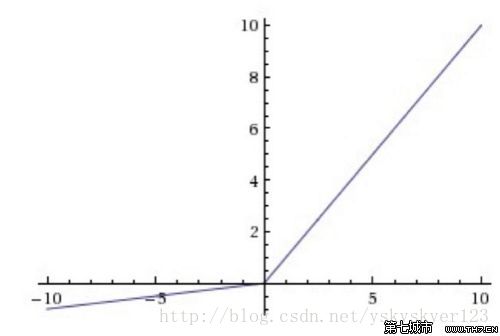1.neuron_layer.hpp 、neuron_layer.cpp
class NeuronLayer 这个类公有继承自Layer类,特点是输入blob数量为1,输出blob数量也为1。
.cpp文件里面就实现了一个函数Reshape(在layer.hpp中Layer类里定义为虚函数),功能是将输出blob的形状改为和输入blob一样。
hpp:
#ifndef CAFFE_NEURON_LAYER_HPP_
#define CAFFE_NEURON_LAYER_HPP_
#include <vector>
#include "caffe/blob.hpp"
#include "caffe/layer.hpp"
#include "caffe/proto/caffe.pb.h"
namespace caffe {
/**
* @brief An interface for layers that take one blob as input (@f$ x @f$)
* and produce one equally-sized blob as output (@f$ y @f$), where
* each element of the output depends only on the corresponding input
* element.
*/
template <typename Dtype>
class NeuronLayer : public Layer<Dtype> {
public:
explicit NeuronLayer(const LayerParameter& param)
: Layer<Dtype>(param) {}
virtual void Reshape(const vector<Blob<Dtype>*>& bottom,
const vector<Blob<Dtype>*>& top);
virtual inline int ExactNumBottomBlobs() const { return 1; }
virtual inline int ExactNumTopBlobs() const { return 1; }
};
} // namespace caffe
#endif // CAFFE_NEURON_LAYER_HPP_
cpp:
#include <vector>
#include "caffe/layers/neuron_layer.hpp"
namespace caffe {
template <typename Dtype>
void NeuronLayer<Dtype>::Reshape(const vector<Blob<Dtype>*>& bottom,
const vector<Blob<Dtype>*>& top) {
top[0]->ReshapeLike(*bottom[0]);
}
INSTANTIATE_CLASS(NeuronLayer);
} // namespace caffe
2.relu_layer.hpp、relu_layer.cpp
relu_layer继承自neuron_layer,所以输入和输出都是一个blob。
cpp文件主要实现了前向传播和反向传播函数。
LeakyRelu图像:
caffe里面关于 ReLUParameter的描述:
message ReLUParameter {
// Allow non-zero slope for negative inputs to speed up optimization
// Described in:
// Maas, A. L., Hannun, A. Y., & Ng, A. Y. (2013). Rectifier nonlinearities
// improve neural network acoustic models. In ICML Workshop on Deep Learning
// for Audio, Speech, and Language Processing.
optional float negative_slope = 1 [default = 0];
enum Engine {
DEFAULT = 0;
CAFFE = 1;
CUDNN = 2;
}
optional Engine engine = 2 [default = DEFAULT];
}所以relu_layer使用的是LeakyRelu,
设输入为x,输出为y。
∂E∂x
为损失函数相对于输入x的倒数
前向传播:
f(x)=max(0,x)+negative_slope×min(0,x)
反向传播:
∂E∂x=⎧⎩⎨∂E∂y,negative_slope∗∂E∂y,if n>0 if n<=0
hpp:
#ifndef CAFFE_RELU_LAYER_HPP_
#define CAFFE_RELU_LAYER_HPP_
#include <vector>
#include "caffe/blob.hpp"
#include "caffe/layer.hpp"
#include "caffe/proto/caffe.pb.h"
#include "caffe/layers/neuron_layer.hpp"
namespace caffe {
/**
* @brief Rectified Linear Unit non-linearity @f$ y = \max(0, x) @f$.
* The simple max is fast to compute, and the function does not saturate.
*/
template <typename Dtype>
class ReLULayer : public NeuronLayer<Dtype> {
public:
/**
* @param param provides ReLUParameter relu_param,
* with ReLULayer options:
* - negative_slope (\b optional, default 0).
* the value @f$ \nu @f$ by which negative values are multiplied.
*/
explicit ReLULayer(const LayerParameter& param)
: NeuronLayer<Dtype>(param) {}
virtual inline const char* type() const { return "ReLU"; }
protected:
/**
* @param bottom input Blob vector (length 1)
* -# @f$ (N \times C \times H \times W) @f$
* the inputs @f$ x @f$
* @param top output Blob vector (length 1)
* -# @f$ (N \times C \times H \times W) @f$
* the computed outputs @f$
* y = \max(0, x)
* @f$ by default. If a non-zero negative_slope @f$ \nu @f$ is provided,
* the computed outputs are @f$ y = \max(0, x) + \nu \min(0, x) @f$.
*/
virtual void Forward_cpu(const vector<Blob<Dtype>*>& bottom,
const vector<Blob<Dtype>*>& top);
virtual void Forward_gpu(const vector<Blob<Dtype>*>& bottom,
const vector<Blob<Dtype>*>& top);
/**
* @brief Computes the error gradient w.r.t. the ReLU inputs.
*
* @param top output Blob vector (length 1), providing the error gradient with
* respect to the outputs
* -# @f$ (N \times C \times H \times W) @f$
* containing error gradients @f$ \frac{\partial E}{\partial y} @f$
* with respect to computed outputs @f$ y @f$
* @param propagate_down see Layer::Backward.
* @param bottom input Blob vector (length 1)
* -# @f$ (N \times C \times H \times W) @f$
* the inputs @f$ x @f$; Backward fills their diff with
* gradients @f$
* \frac{\partial E}{\partial x} = \left\{
* \begin{array}{lr}
* 0 & \mathrm{if} \; x \le 0 \\
* \frac{\partial E}{\partial y} & \mathrm{if} \; x > 0
* \end{array} \right.
* @f$ if propagate_down[0], by default.
* If a non-zero negative_slope @f$ \nu @f$ is provided,
* the computed gradients are @f$
* \frac{\partial E}{\partial x} = \left\{
* \begin{array}{lr}
* \nu \frac{\partial E}{\partial y} & \mathrm{if} \; x \le 0 \\
* \frac{\partial E}{\partial y} & \mathrm{if} \; x > 0
* \end{array} \right.
* @f$.
*/
virtual void Backward_cpu(const vector<Blob<Dtype>*>& top,
const vector<bool>& propagate_down, const vector<Blob<Dtype>*>& bottom);
virtual void Backward_gpu(const vector<Blob<Dtype>*>& top,
const vector<bool>& propagate_down, const vector<Blob<Dtype>*>& bottom);
};
} // namespace caffe
#endif // CAFFE_RELU_LAYER_HPP_
cpp:
#include <algorithm>
#include <vector>
#include "caffe/layers/relu_layer.hpp"
namespace caffe {
template <typename Dtype>
void ReLULayer<Dtype>::Forward_cpu(const vector<Blob<Dtype>*>& bottom,
const vector<Blob<Dtype>*>& top) {
const Dtype* bottom_data = bottom[0]->cpu_data();
Dtype* top_data = top[0]->mutable_cpu_data();
const int count = bottom[0]->count();
Dtype negative_slope = this->layer_param_.relu_param().negative_slope();
for (int i = 0; i < count; ++i) {
top_data[i] = std::max(bottom_data[i], Dtype(0))
+ negative_slope * std::min(bottom_data[i], Dtype(0));
}
}
template <typename Dtype>
void ReLULayer<Dtype>::Backward_cpu(const vector<Blob<Dtype>*>& top,
const vector<bool>& propagate_down,
const vector<Blob<Dtype>*>& bottom) {
if (propagate_down[0]) {
const Dtype* bottom_data = bottom[0]->cpu_data();
const Dtype* top_diff = top[0]->cpu_diff();
Dtype* bottom_diff = bottom[0]->mutable_cpu_diff();
const int count = bottom[0]->count();
Dtype negative_slope = this->layer_param_.relu_param().negative_slope();
for (int i = 0; i < count; ++i) {
bottom_diff[i] = top_diff[i] * ((bottom_data[i] > 0)
+ negative_slope * (bottom_data[i] <= 0));
}
}
}
#ifdef CPU_ONLY
STUB_GPU(ReLULayer);
#endif
INSTANTIATE_CLASS(ReLULayer);
} // namespace caffe























 391
391

 被折叠的 条评论
为什么被折叠?
被折叠的 条评论
为什么被折叠?








